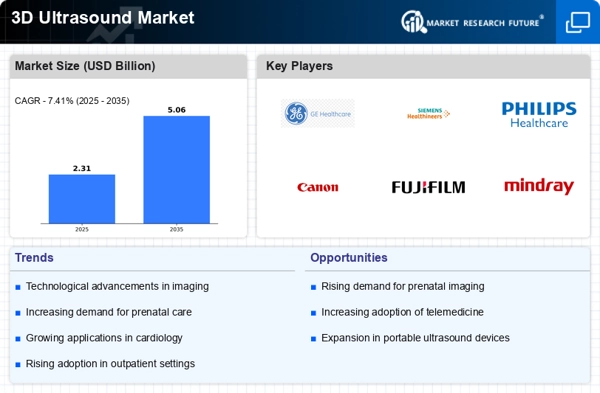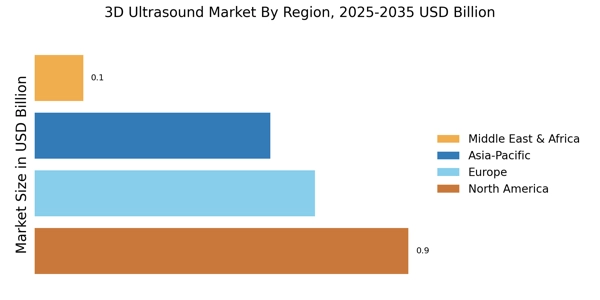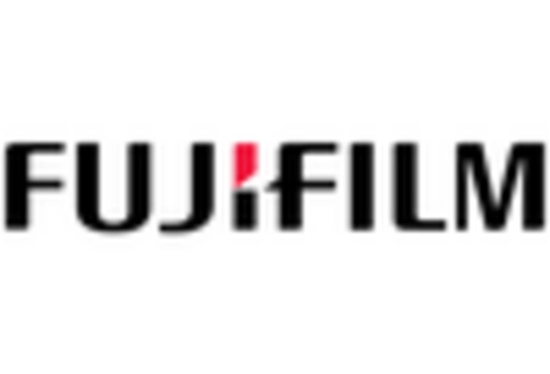Focus on Prenatal Imaging
The 3D Ultrasound Market is significantly influenced by the growing focus on prenatal imaging. Expectant parents are increasingly seeking advanced imaging options to monitor fetal development and ensure the health of the unborn child. 3D ultrasound provides detailed visualizations that can enhance the bonding experience between parents and their child. This trend is supported by data indicating that nearly 70% of expectant mothers opt for 3D or 4D ultrasound scans during their pregnancy. As healthcare providers recognize the importance of comprehensive prenatal care, the demand for 3D ultrasound services is expected to rise, further propelling the growth of the 3D Ultrasound Market.
Technological Advancements in Imaging
The 3D Ultrasound Market is experiencing a surge in technological advancements that enhance imaging capabilities. Innovations such as improved transducer technology and advanced software algorithms are enabling clearer and more detailed images. These advancements not only improve diagnostic accuracy but also facilitate better patient outcomes. The integration of artificial intelligence in image analysis is also gaining traction, potentially streamlining workflows and reducing the time required for image interpretation. As a result, healthcare providers are increasingly adopting 3D ultrasound systems, which are projected to grow at a compound annual growth rate of approximately 8% over the next five years. This trend indicates a robust demand for advanced imaging solutions within the 3D Ultrasound Market.
Rising Awareness of Diagnostic Benefits
The 3D Ultrasound Market is benefiting from a rising awareness of the diagnostic advantages associated with 3D imaging. Healthcare professionals are increasingly recognizing that 3D ultrasound can provide superior visualization of anatomical structures compared to traditional 2D imaging. This heightened awareness is leading to more frequent utilization of 3D ultrasound in various medical fields, including cardiology and musculoskeletal imaging. As practitioners become more educated about the capabilities of 3D ultrasound, the market is likely to see an uptick in adoption rates. This trend suggests a promising future for the 3D Ultrasound Market, as more healthcare facilities invest in advanced imaging technologies.
Increased Demand for Non-Invasive Procedures
The 3D Ultrasound Market is witnessing a notable increase in demand for non-invasive diagnostic procedures. Patients and healthcare providers alike are gravitating towards methods that minimize risk and discomfort. 3D ultrasound technology offers a non-invasive alternative to traditional imaging techniques, making it particularly appealing for prenatal imaging and other applications. This shift is reflected in the rising number of procedures performed annually, with estimates suggesting that the use of 3D ultrasound in obstetrics has increased by over 20% in recent years. As awareness of the benefits of non-invasive imaging grows, the 3D Ultrasound Market is likely to expand further, driven by patient preference and clinical efficacy.
Growing Investment in Healthcare Infrastructure
The 3D Ultrasound Market is poised for growth due to increasing investments in healthcare infrastructure. Governments and private entities are allocating substantial resources to enhance medical facilities and upgrade imaging technologies. This investment is particularly evident in emerging markets, where the demand for advanced diagnostic tools is on the rise. As healthcare systems expand and modernize, the adoption of 3D ultrasound technology is expected to increase, driven by the need for efficient and accurate diagnostic solutions. The influx of capital into healthcare infrastructure is likely to create a favorable environment for the 3D Ultrasound Market, fostering innovation and accessibility.


















Leave a Comment